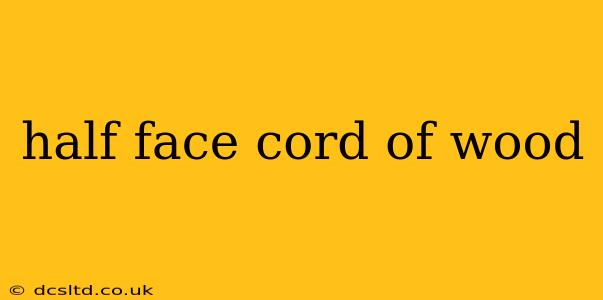Buying firewood can be confusing, especially with the various measurement units used. One common unit, often causing head-scratching, is the "half face cord." This guide will demystify this measurement, explaining what it is, how it compares to other units, and how to ensure you're getting what you pay for.
What is a Half Face Cord of Wood?
A face cord of wood is a stack of wood that is 4 feet high and 8 feet long, but the thickness of the pieces can vary. This variability is precisely why a face cord isn't a standard unit of volume. A half face cord, therefore, is simply half of a face cord. That means a stack measuring 4 feet high by 4 feet long, again with variable thickness. This translates to a stack that takes up 16 square feet. Keep in mind that a half face cord doesn't represent a consistent volume of wood like a cubic foot or a cord.
How Many Cubic Feet are in a Half Face Cord?
This is where things get tricky. Because the thickness of the wood pieces isn't standardized in a face cord (or half face cord), you can't give a precise cubic foot measurement. The actual volume of wood in a half face cord depends entirely on the length and thickness of the individual pieces. A stack with longer, thicker pieces will contain significantly more wood than a stack with shorter, thinner pieces.
How Does a Half Face Cord Compare to a Full Cord?
A full cord of wood is a standard unit of volume, measuring 4 feet high, 4 feet wide, and 8 feet long (128 cubic feet). This is a much larger quantity of wood than a half face cord. In fact, a half face cord is only a fraction of a cord, representing roughly 1/8th of a standard cord (if the pieces have an average thickness). However, it's important to reiterate that this is an approximation and can vary widely depending on wood thickness.
How Much Wood is in a Half Face Cord? Is it enough for my needs?
Determining if a half face cord is sufficient for your heating needs depends heavily on several factors:
- The size of your fireplace or wood stove: Larger appliances require more wood.
- The efficiency of your appliance: A more efficient stove will require less wood to produce the same amount of heat.
- The type of wood: Different wood types have varying heat outputs and burn rates.
- Your climate and heating requirements: Colder climates and longer heating seasons will demand more firewood.
To assess if a half face cord is enough, consider how much wood you burned in previous heating seasons. Consulting a local firewood supplier or calculating your heating requirements based on your home's square footage and insulation level might also be necessary.
What is the difference between a half face cord and a rick of wood?
The term "rick" is another variable measure of firewood. Similar to a face cord, it relies on stacked wood, usually about 4 feet high, but the length can vary. This makes comparison between a rick and a half face cord difficult and unpredictable without knowing the length of the ricks.
How can I avoid getting cheated when buying firewood?
The best way to avoid being misled is to purchase wood by the cord or cubic foot. These are standardized measures, offering more clarity. However, if a half-face cord is the only option:
- Clearly define the dimensions: Ensure you agree on the height and length of the stack before purchase.
- Inspect the wood: Check the length and thickness of the pieces. If it appears significantly thinner than expected, consider negotiating the price.
- Negotiate a price per cubic foot (if possible): This will give you a more accurate reflection of the wood's value.
By understanding the limitations of the half face cord and carefully examining the wood before purchase, you can ensure you receive the value you expect. Remember, clear communication and measurement verification are key to a successful firewood transaction.
